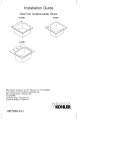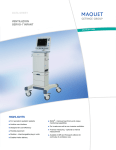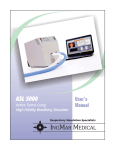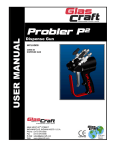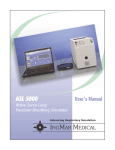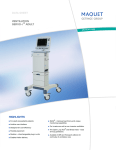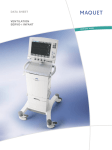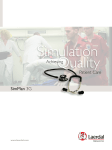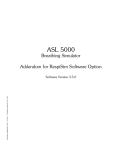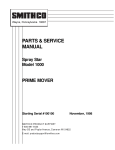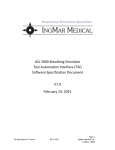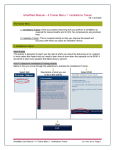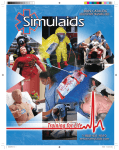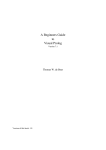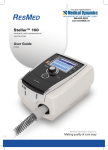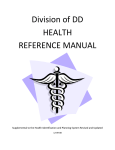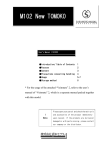Download User`s Manual - IngMar Medical
Transcript
Adult/Pediatric Demonstration Lung Model User’s Manual © IngMar Medical, Ltd. 2014 This page intentionally left blank Adult/Pediatric Lung® Users Manual, © IngMar Medical, Ltd. 2014 2 Adult/Pediatric Lung User’s Manual Legal Information Product Warranty Educational tools and test instruments manufactured or distributed by IngMar Medical Ltd., are fully warranted, covering materials and workmanship, for a period of one year from the date of shipment, except for products with stated warranties other than one year. IngMar Medical reserves the right to perform warranty service(s) at its factory, at an authorized repair station, or at the customer's installation. IngMar Medical's obligations under this warranty are limited to repairs, or at IngMar Medical's option, replacement of any defective parts of our equipment, except fuses and batteries, without charge, if said defects occur during normal service. Claims for damages during shipment must be filed promptly with the transportation company. All correspondence concerning the equipment must specify both the model name and number, and the serial number as it appears on the equipment. Adult/Pediatric Lung® Users Manual, © IngMar Medical, Ltd. 2014 Improper use, mishandling, tampering with, or operation of the equipment without following specific operating instructions will void this warranty and release IngMar Medical from any further warranty obligations. The above is the sole warranty provided by IngMar Medical, Ltd. No other warranty, expressed or implied, is intended. Representatives of IngMar Medical are not authorized to modify the terms of this warranty. For factory repair service, call: Toll free: 1-800-583-9910 International: (412) 441-8228 Facsimile: (412) 441-8404 or contact us via e-mail at: [email protected] before sending in any products for repair, calibrations, or updates. Limitation of Liability IngMar Medical Ltd.'s liability, whether arising out of or related to manufacture and sale of the goods, their installation, demonstration, sales representation, use, performance, or otherwise, including any liability based upon above defined product warranty, is subject to and limited to the exclusive terms and conditions as set forth, whether based upon breach of warranty or any other cause of action whatsoever, regardless of any fault attributable to IngMar Medical, and regardless of the form of action (including, without limitation, breach of warranty, negligence, strict liability, or otherwise). THE STATED EXPRESSED WARRANTIES ARE IN LIEU OF ALL OTHER WARRANTIES, EXPRESSED OR IMPLIED, INCLUDING, WITHOUT LIMITATION, WARRANTIES OF MERCHANTABILITY, FITNESS FOR ANY PARTICULAR PURPOSE, OR NONINFRINGEMENT. IngMar Medical, Ltd. shall not be liable for, nor shall buyer be entitled to recover, any special incidental or consequential damages or for any liability incurred by buyer to any third party in any way arising out of or relating to the goods. Copyright © 1998-2014, IngMar Medical, Ltd. This document may not be reproduced, stored in a retrieval system, translated, transcribed, or transmitted, in any form, or by any means, without prior explicit written permission from IngMar Medical Ltd. Our shipping address: IngMar Medical, Ltd. 5940 Baum Blvd Pittsburgh, PA 15206 USA Please note that a valid return merchandise authorization (RMA) number is always required 3 Adult/Pediatric Lung User’s Manual Contents 1 Operator Safety ..............................................5 1.1 Definitions ...................................................5 1.2 Intended Use ................................................5 1.3 General Precautions .....................................5 2 Applications ....................................................5 2.1 Ventilator Functions .....................................5 2.2 Flow/Volume Monitoring .............................6 2.3 Waveforms ...................................................6 2.3.1. Pressure Waveforms .................................6 2.3.2. Flow Waveforms ......................................6 3 Operation .......................................................8 3.1 Preparing for Operation ...............................8 3.2 Changing Lung Model Parameters ................8 3.3 Obtaining System Pressure Information ......10 3.3.1. Pressure Measurement with Pressure Gauges… ................. Error! Bookmark not defined. 4 Cleaning and Care ........................................10 4.1 Cleaning ......... Error! Bookmark not defined. 4.2 Storage & Travel .........................................10 5 Troubleshooting ...Error! Bookmark not defined. 5.1 Leakage………………………………………...10 5.2 Springs………………………………………….10 6 Data ..............................................................11 6.2 Flow vs Pressure for Leakage Orfices………..11 6.3 Volume vs Pressure for 1,2, & 3 Springs…….11 4 Adult/Pediatric Lung® Users Manual, © IngMar Medical, Ltd. 2014 6.1 Resistance vs Flow for Resistance Orfices….. 11 Adult/Pediatric Lung User’s Manual 1 Operator Safety For correct and effective use of the product it is mandatory to read and to observe all instructions, WARNINGS, and CAUTION statements in this manual. If the product is not used as instructed, the safety protection provided may be impaired. 1.1 Overview CAUTION ! In addition, a non-linearity may be introduced to simulate lung overdistension, with the additional elastance engaging at 1/3 L for both bellows. Leak rates may be varied from 5 L/min at 10 cmH2O to 25 L/min at 40 cmH2O (for exact relationship between pressure and leak, see diagrams under 7. Data). One leak parameter represents a leak caused by a pneumothorax-type rupture in the lung (compartment leak), the other parameter adjusts an ET-tube leak (leak before resistance). Indicates a condition that may lead to equipment damage or malfunction collaboration with time saving features for instructors to provide higher quality and more consistent training content, higher skill levels for students, and ultimately better patient care. NOTE: Indicates points of particular interest or emphasis for more efficient or convenient operation. The overall diagram for the simulation looks like this: Controls are designated as «Controlname». Adult/Pediatric Lung® Users Manual, © IngMar Medical, Ltd. 2014 The basic IngMar Medical Adult/Pediatric Demonstration Lung Model is a passive lung simulator for simulating pediatric and adult patients. It complements the IngMar Medical Neonatal Lung Model that is available for education regarding neonatal ventilators. The Adult/Pediatric Lung Model consists of a twobellow compliance that is ventilated through valves representing resistances and leaks. The bellow and valve assembly is contained in an aluminum case with lid with dimensions of approximately 8.5 x 12.5 x 6 inches weighing less than 15 lbs. The simulator is operated pneumatically and does not require any electrical connections in its base configuration. Resistances and leaks are set with rotary knobs that feature 90o click stops for different settings. Compliances are set by engaging torsion springs with easy to operate grip latches. 1.3 Options System pressure can be measured via optional analog pressure gauges (-10 to 100 cmH2O) at the patient connector (airway pressure), and at each compliance (lung pressure). 1.2 Features Each compartment represents a maximum lung volume of approximately 1 L. For each compliance, resistance can be set independently and may be varied from 5 to 50 cmH2O/L/s (5, 15, 50 with standard orifices at 20 L/min). Compliance can be varied in the range of 40 to 17 mL/cmH2O (40, 30, 20, 17) for each compartment. 2 Applications 2.1 Ventilator Functions The following section gives some examples of applications where the IngMar Medical Adult/Pediatric Lung Model may be used. These are intended as suggestions rather than a 5 Adult/Pediatric Lung User’s Manual comprehensive listing of all potential applications. decompression (pneumothorax), chest tube insertion, and cricothyrotomy and tracheotomy procedures. The RespiPatient consists of a torso manikin which connects to an Interface Box. The RespiPatient Interface box drives the features of the manikin using IngMar Medical’s ASL 5000 Breathing Simulator to provide high-fidelity, spontaneously breathing lungs. RespiPatient enables you to train the full range of airway management and CPR skills with anatomically correct airway, rib cage, three-layered tissue, “real feel” skin covering, and realistic chest rise. Replaceable tissue sets allow each learner a life-like and unique experience for training. 2.2 Flow/Volume Monitoring Using an adjustable lung model is particularly helpful for teaching about ventilators capable of monitoring flow and volume (or are connected to a device that performs this function). When the ventilator is connected to a (simulated) patient, the actual values of tidal volume VT, minute ventilation *, and airway leaks can be made visible and provide a guideline that is invaluable in clinical practice. With the lung model, it is possible to simulate conditions influencing above parameters, such as compliance, resistance, and leak. 2.3 Waveforms With the setting of Resistance to «1» (standard) and compliance to «1» ("no spring", 40 mL/cmH2O) a characteristic waveform pattern will be produced according to the ventilator inspiratory time, flow, and pressure limit (see Fig. 2 for an example) Paw=1/C x V + R x * In cases where resistance is different between the two compartments (represented by different settings of resistance valves for the two bellows), the effects can be studied first individually and then in combination. Extremely different parameters result in a "Pendelluft" effect that is a process of equilibration between the two compartments. It is visualized best during an extended inspiratory hold set for the ventilator. The effects of not allowing for sufficient time for equilibrium, namely very uneven distribution of ventilation between the compartments, can, of course, be simulated as well. Recognition of correct position in the 5th intercostal space ! Blunt dissection through chest wall Surgical skills ! Cricothyrotomy ! Tracheotomy CO2 production for capnography Torso manikin easier to move and store than full body manikin ! • • • 2.3.2.Flow Waveforms Flow is another parameter frequently visualized on ventilator graphics screens. A flow waveform can tell the therapist whether exhalation is complete or whether air trapping has occurred with particular ventilator settings. This is indicated by flows that are not zero at the end of expiration, immediately before the next inspiratory cycle forces more air into the lungs. With a lung model, changing patient conditions responsible for developing air trapping can easily be recreated, e.g. by increasing resistance substantially. With air trapping, the affected bellow of the model will not have returned to its closed position at the end of expiration. Other effects to be studied are peak flows versus lung resistance. 2.3.4 Ventilation in the Presence of Leaks 6 Adult/Pediatric Lung® Users Manual, © IngMar Medical, Ltd. 2014 2.3.1.Pressure Waveforms With increased resistance, initial ramp steepness is decreased since it depends, in its initial slope, on resistance of the ventilated system. At this point, flow going into the lungs is limited by resistance rather than by compliance in the equation of motion: Adult/Pediatric Lung User’s Manual The IngMar Lung Model provides two types of simulated leaks. With the left leak valve, a leak at the ET-tube is simulated ( RL-ET ). The right leak valve controls a bellow leak in the right compartment. The difference between these two types of leaks is that an ET-tube leak affects both compartments simultaneously, while a bellow leak may become responsible for severely uneven filling of lung compartments. From Fig.1 (see page 7) it becomes clear that another difference is the resistance located between the ventilator and the leaking compartment in case of a bellow leak. Depending on its size, this leak might have a much less noticeable effect on the ventilator. For relationship between pressure and leakage flow through the different orifices provided. 2.3.5 Synchronized Ventilation Adult/Pediatric Lung® Users Manual, © IngMar Medical, Ltd. 2014 The IngMar Medical Adult/Pediatric Lung Model provides an easy way to simulate spontaneous inspiration. In order to initiate a triggered ventilator breath, the user simply has to pull slightly on the rubber bellow lid knobs. The ventilator response can be felt and judged both in terms of delay and force necessary to trigger a response. 7 Adult/Pediatric Lung User’s Manual - Set resistance to «1» on first bellow, to «0» on second. 3 Operation 3.1 Preparing for Operation 1. Place the Adult/Pediatric Lung Model on a flat surface within easy reach of the ventilator circuit. 2. Make sure that: - supporting surface is appropriate for load (15 lbs) all knobs intended to be used are within reach for the instructor. - Apply approximately 50 cmH2O pressure using the manual breath function of the ventilator (ventilator in IMV mode with lowest rate. When bellow has expanded fully, turn resistance of bellow to «0» (R=∞) and release pressure from ventilator. Observe bellow. During the next few seconds, bel- low should not move, indicating there are no leaks. - Repeat procedure for second bellow accordingly. 3. Unlatch lid and prop up. - Make sure that pressure gauges can be viewed by students. 3a. Alternatively, remove case lid. 4. Disconnect pressure gauge lines by twisting connectors below gauges counterclockwise - Pull lid prop rod from lid (gently move to left after closing lid approximately half way. - Pull both L-shaped hinge securing pins outwards with your finger and pull lidoff its hinges. If the type of wye used has a tendency to kink hoses, consider using an elbow to accomodate an angle 9. Set parameters according to the intended subject of instruction. The device is now ready for demonstrations. 3.2 Changing Lung Model Parameters Compliance is adjusted individually for each bellow with torsion springs that can be engaged to alter the opening force for the bellows. NOTE: Spring settings should only be changed while bellows are not moving and in their closed position. For resulting compliances (approximate values), please refer to table below: 6. Preset parameters for the topic of instruction to be covered (see 2. Application). 7. Verify simulator operation by pressurizing bellows and checking for leak. - Engage «no. 2» spring on both bellows - Set leaks to «0». 8 Spring no. 3 is used to simulate lung overdistension and is activated at preset tidal Adult/Pediatric Lung® Users Manual, © IngMar Medical, Ltd. 2014 5. Connect ventilator circuit wye to 15 mm ISO port on the left side of the simulator case. 8. If leak is detected, refer to section 5. Troubleshooting. Adult/Pediatric Lung User’s Manual - an ET-tube leak, and volume of 250 mL. 1. Engaging a spring: In order to engage a spring, first verify that the respective grip latch is fully open (yellow pointer in 11 o'clock position). - Turn knob (1, 2, or 3) clockwise and tighten. Verify visually that spring is engaged when bellow is opened up (yellow pointer in 4 o'clock position). 2. Disengaging a spring - Turn knob (1, 2, or 3) counterclockwise until pointer indicates that pawl has turned (yellow pointer in11 o'clock position). - a lung leakage in one compartment. While an ET-tube leak affects both compartments and is located before the simulated airway resistance, lung leakage is intended to show the effect of a pneumothorax (please refer to scheme on page 11. The left center knob on the instrument case operates the ET- tube leak, the right center knob adjusts a leak in the second (right) bellow assembly. For the relationship between pressure and leakage flow please refer to the respective diagram - Verify visually that spring is disengaged when bellow is opened up. 3.2.2 Resistance Resistance is adjusted with the outer knobs on the instrument case, individually for each bellow. Setting an ET-tube leak - Set left center knob to either «1», «2», or «3» to simulate a small, medium, or large ET-tube leak, respectively. - To turn leak off, set dial to OFF. Adult/Pediatric Lung® Users Manual, © IngMar Medical, Ltd. 2014 Setting a compartment leak Settings are labeled «OFF» and «1» through «3» representing resistance values according to the table on the next page. - - Set right center knob to either «1», «2», or «3» to simulate a small, medium, or large leak, respectively. To turn leak off, set dial to «OFF». 3.3 Obtaining System Pressure Information Values may be changed during operation. Resistances are the same for the respective settings of both compartments. 3.2.3 Leak Two different types of leaks can be simulated with the IngMar Medical Adult/Pediatric Demonstration Lung Model, 3.3.1.Pressure Measurement with Pressure Gauges 1. Verify proper connection of lid-mounted pressure gauges to instrument with subminiature quick connects . (Turn clockwise over click to engage, counterclockwise to disen- gage.) 2. Set maximum pressure recording pointer 9 Adult/Pediatric Lung User’s Manual manually to 0 (on all gauges). 5 Troubleshooting 3. Read maximum pressures. - Lung pressures on left-/right-hand gauges Airway pressure on center gauge. NOTE: Lid with pressure gauges may be removed from case for better visibility during instruction. Connecting pressure lines will then have to be extended.( 4 Cleaning and Care 4.1 Cleaning The instrument should not require specific cleaning during routine use. It is not intended to form part of a sterile patient circuit and can therefore not be sterilized. The outer surface of the instrument case may be wiped off with a damp cloth using a mild detergent. CAUTION ! 5.1 Leakage If there seems to be inappropriate leakage of a bellow, verify that leak valves are in closed position. If leak persists, turn leak and resistance knobs once 360° to reset internal valve o-rings. Also check free movement of knobs (damage?). 5.2 Springs If compliance settings seem not to correspond to springs engaged, verify that all respective springs are activated appropriately. If a spring leg has not been pulled up by its grip latch pawl, open grip latch almost fully (continue opening several turns after pointer has indicated pawl has turned into 11 o'clock position). Afterwards,tighten spring leg again by turning knob clockwise. Visually inspect by closely looking at movement of spring leg with opening of bellow. Do not immerse instrument in cleaning or disinfecting solutions. Moisture inside the bellow system should be removed promptly by ventilating instrument with dry air. 4.2 Storage & Travel Always use care and diligence as with any other technical instrument to prevent physical damage. CAUTION ! Always leave bellows open (Resistance set to 1,2, or 3) when exposing instrument to ambient pressure fluctuations, e.g. during air travel. Otherwise, damage to pressure gauges to excessive pressure might result. 10 Adult/Pediatric Lung® Users Manual, © IngMar Medical, Ltd. 2014 Store instrument in a cool and dry place. Rubber components may age prematurely if exposed to heat. Use padded nylon case (option 25 00 000) for storage if available. Adult/Pediatric Lung User’s Manual 6 Data 6.1 Resistance Versus Flow for Resistance Orifices 6.3 Volume Versus Pressure for No.1,2, and 3 Springs Adult/Pediatric Lung® Users Manual, © IngMar Medical, Ltd. 2014 6.2 Flow Versus Pressure for Leakage Orifices 11












